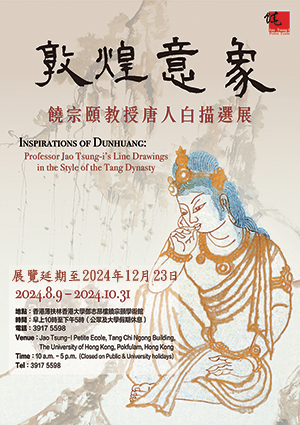其他活動
敦煌意象──饒宗頤教授唐人白描選展

| 日期: | 2024年8月9日 - 2024年10月31日 |
| 展覽延期至2024年12月23日 | |
| 時間: | 上午10時至下午5時 (公眾及大學假期休息) |
| 地點: | 香港薄扶林香港大學鄧志昂樓饒宗頤學術館 |
| 查詢: | 3917 5598 |
前言
饒宗頤教授與敦煌的關係,是早於上世紀六十年代已經開始。當年,饒教授對學術界的一句傳言,說「敦煌在中國,但敦煌學在日本」,很是心酸;因此,他要重新推動敦煌學的研究。剛巧他在法國及日本看到很多敦煌經卷,亦利用這些資料寫出許多學術及藝術方面的著作。同時,他在這些經卷的後面也看到不少由北魏到唐宋的白描畫稿。他曾指出,唐代的繪畫真跡到今日,如鳳毛麟角般難得一見;但是他發現,這些唐人經卷後的畫稿,其實就是唐人的畫跡。故此,他不但作出深入的研究,而且更進一步在這些白描畫稿中發展出他的白描風格。
此次展出的十二件展品,是選取他極具代表性的敦煌白描畫作,包括花鳥及佛像。在這些作品中,我們可以看見饒教授在唐人筆法上,變化出他自己古樸而流暢的神態。這種神態,又別於宋代李公麟及元代趙孟頫的描法,可說是別開白描的一個路向。
Inspirations of Dunhuang: Professor Jao Tsung-i’s Line Drawings in the Style of the Tang Dynasty
Introduction
Professor Jao Tsung-i's profound connection with Dunhuang dates back to the 1960s. Disheartened by theprevalent belief that "Dunhuang is in China, but Dunhuang studies are in Japan," he was driven to revivethe study of Dunhuang. By chance, he encounterednumerous Dunhuang scrolls in France and Japan, which he used as source material for various scholarly and artistic publications. On many scrolls, after the manuscripts, he discovered line drawings spanning fromthe Northern Wei dynasty to the Tang and Song dynasties. While he had previously noted the rarity of authentic Tang dynasty paintings even today, he realizedthat the drawings behind these Tang dynasty scrolls were genuinely from that era. This discovery spurred him toconduct in-depth research and further developed his line-drawing style based on the manuscripts.
The exhibition features twelve artworks, carefully selected as the finest examples of Professor Jao’s Dunhuang line drawings. These pieces, including bird-and-flower subjects and Buddhist figures, reflect his unsophisticated yet flowing style rooted in the brushwork of the Tang period. Diverging from the depictions of Li Gonglin of the Song dynasty and Zhao Mengfu of the Yuan dynasty, his work marks a novel approach to this painting manner.
